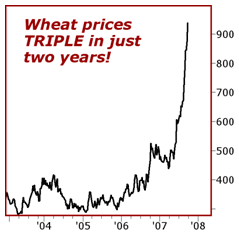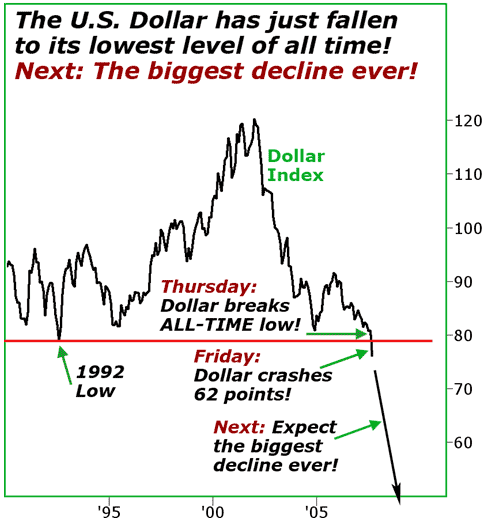US Dollar Crash - Explosion in Currencies, Gold, Crude Oil, Food! Urgent Steps ...
Currencies / US Dollar Oct 01, 2007 - 09:15 AM GMT The dollar's crash is now so fast and so severe, it's setting off nearly every other market on the planet:
The dollar's crash is now so fast and so severe, it's setting off nearly every other market on the planet: ![]() Foreign currencies are exploding!
Foreign currencies are exploding!
The euro has just catapulted to 1.427, its seventh consecutive all-time record high.
The Canadian dollar has surged from 61.79 U.S. cents only five years ago to over $1.00, a 31-year high.
The Brazilian real has made its highest close since September 2000.
The Indian rupee is close to a nine-year peak.
Even currencies like the Philippine peso and the Botswana pula are now strengthening against the U.S. dollar.
![]() Gold has just hit its highest level in 27 years!
Gold has just hit its highest level in 27 years!
The price of gold (based on December futures) has jumped to $750, the highest since January 22, 1980. That was just one day after it had spiked to its all-time record high of $873.
Meanwhile, the amount invested in the StreetTracks Gold Trust, the leading ETF backed by bullion, has soared to a record 578 metric tons — making it the world's 11th biggest holder of gold. At this rate, it could soon have more gold than the government of China.
![]() Commodities have just had their biggest monthly gain in 32 years!
Commodities have just had their biggest monthly gain in 32 years!

The CRB Index, representing 19 commodities, has surged 8.1% this month, the most since July 1975.
Crude oil has hit $83.90 a barrel, the highest ever.
And wheat, helped along by droughts in Australia, has absolutely gone ballistic, reaching a record $9.51 per bushel. That's more than triple its level of just two years ago.
In addition, due to the dollar decline, expect impacts on U.S. bond markets, the U.S. mortgage market and the U.S. stock market. Everywhere, the greenback's fall will leave its mark.
How Wall Street Wags Scoffed at Our Warnings. Why They're Just Now Beginning to See the Light.
For months now, we've felt like lone voices crying in the wilderness. We warned you that ...
- the U.S. housing and mortgage markets would collapse ...
- the Fed would overreact, slashing interest rates and pumping huge amounts of money into the U.S. economy, and ...
- the U.S. dollar was headed for one of its worst routs in history.
We urged you — nagged you — to protect yourself, even to use this crisis to go for potentially very large profits.
But Wall Street wags scoffed every step of the way. “The housing decline is no big deal,” they said. “The dollar decline is gradual and even good for the economy,” they swore.
But now, with the dollar crash gaining momentum, some on Wall Street are finally beginning to see the light. And the press has even started to recognize some of the other voices now warning about this disaster.

Last week, for example, the New York Times published a stinging editorial by Morgan Stanley's Asia Chairman, Stephen S. Roach.
His main point: So far, the dollar decline has been orderly. Now, however, “ the possibility of a disorderly correction is rising with potentially grave consequences .”
Translation: A sudden, devastating global crash in the value of the U.S. dollar, launching the value of foreign currencies like a rocket.
His reasons: A series of massively powerful phenomena that have been building up for many years and are just now beginning to burst onto the scene ...
Phenomenon #1: Americans have virtually abandoned the age-old practice of saving money.
In 2005, for example, the personal savings rate of Americans dipped below zero . Consumers actually depleted their net savings to finance purchases of mansions, SUVs and other big-ticket items.
Hard to believe? Yes.
True? Absolutely!
Indeed, this unusual situation occurred only once before — in the early 1930s.
At that time, the entire nation was slammed by a banking collapse, massive business failures and the worst job layoffs of the century. So dipping temporarily into savings was understandable. But in times of prosperity like 2005?
It was sheer madness.
And even since 2005, the most the average American household has saved is a fraction of a penny per dollar of disposable income.
Phenomenon #2: In order to continue growing, the United States borrowed massively from the hard-earned savings of foreign households.
The U.S. borrowed from households in Japan, Germany and elsewhere — families that save 10, 15, even 20 times more than Americans.
That's why America must now attract some $3 billion of foreign capital each and every business day in order to keep its economy growing.
And that's why we now owe foreign investors and governments over 7 trillion dollars , according to the U.S. Treasury.
Phenomenon #3: The dollar decline is accelerating in large part because of the bursting of the subprime mortgage bubble.
Morgan Stanley's Roach compares the housing and mortgage bust to the tech wreck of the early 2000s:
“In both cases,” he writes, “financial markets and policy makers were steeped in denial over the risks. But the lessons of post-bubble adjustments are clear. And ... sadly, the endgame could be considerably more treacherous for the United States than it was seven years ago.
“In large part, that's because the American consumer is now at risk. Consumption expenditures currently account for a record 72 percent of the gross domestic product — a number unmatched in the annals of modern history for any nation.
“This buying binge,” Roach continues, “has been increasingly supported by housing and lending bubbles. Yet home prices are now headed lower — probably for years — and the fallout from the subprime crisis has seriously crimped home mortgage refinancing.”
Phenomenon #4: The days of open-ended American consumption are likely to finally come to an end, making it hard to avoid a recession.
The consequences: “Fearful of that possibility, foreign investors are becoming increasingly skittish over buying dollar-based assets ... Foreign appetite for United States financial instruments is likely to be sharply reduced for years to come. That would choke off an important avenue of capital inflows, putting more downward pressure on the dollar.”
Phenomenon #5: The political winds are also blowing against the dollar.
“In Washington,” Roach reminds us, “China-bashing is the bipartisan sport du jour. New legislation is likely that would impose trade sanctions on China unless it makes a major adjustment in its currency. Not only would this be an egregious policy blunder — attempting to fix a multilateral deficit with more than 40 nations by forcing an exchange rate adjustment with one country — but it would also amount to Washington taxing one of America's major foreign lenders.
“That would undoubtedly reduce China's desire for United States assets, and unless another foreign buyer stepped up, the dollar would come under even more pressure.”
Translation: China will have to let the yuan surge. And Japan, which competes and trades heavily with China, will have to let the yen do the same.
Phenomenon #6: The more Fed Chairman Ben Bernanke follows the Alan Greenspan easy-money script in response to the housing collapse, the greater the risk to the dollar.
Yet that's precisely what Bernanke is doing, and will continue to do. Roach's final word:
“Optimists may draw comfort from the vision of an export-led renewal arising from a more competitive dollar. Yet history is clear: No nation has ever devalued its way into prosperity.
“So far, the dollar's weakness has not been a big deal. That may now be about to change. Relative to the rest of the world, the United States looks painfully subprime. So does its currency.”
Latest Events Drive Home Our Arguments: The Housing Collapse Is Gaining Momentum, And The Dollar's Woes Have Barely Begun ...
Between July and August, the sales of existing homes plunged 4.3% to an annual rate of 5.5 million, the lowest reading in five years .
Meanwhile, existing homes, condos and co-ops up for sale jumped more than 19% from a year ago to 4.58 million units, the highest level in recorded U.S. history.
We now have about two million more single-family houses on the market than was typical in the 1990s and early 2000s. Even compared to the previous peak in the1980s, we now have about 900,000 more homes for sale.
Result: Home prices are plunging nationwide, and in key areas of the country, they're in a virtual free fall. The average home price is down 9.7% in Detroit, 8.8% in Tampa, 7.8% in San Diego and 7.3% in Phoenix.
Any region that has a crummy economy, or that was a hotbed of speculative activity during the boom, is getting crushed.
Foreclosure filings skyrocketed 115.3% to almost 244,000 in August. Nevada was the hardest hit state, with one in every 165 households in foreclosure. California, Florida and Georgia are not far behind.
And unlike the average home seller, banks and lenders don't mess around. They don't hold the homes they repossess on the market for months at inflated prices. They price them low. With more and more owners being foreclosed on — and more and more of those homes flooding the market — traditional sellers are going to have to cut their own prices to compete.
All this just underscores the wisdom and timeliness of our warnings — and Roach's — that ...
|
And as you can see in our chart below, it's already happening right now ...

On Thursday of last week, the U.S. Dollar Index, measured against a basket of the world's main currencies, broke its all-time low made in 1992. That was the watershed.
So on Friday, the dollar crashed 62 basis points, falling clearly below that all-time low.
And next, you can expect the biggest decline ever.
Don't Wait! Take These Steps Urgently!
Step 1. For a good portion of your portfolio, get the heck out U.S. dollars.
Step 2. Move to foreign currencies, gold, resources and other assets that inevitably go up when the dollar falls.
Step 3. Even take advantage of the dollar plunge to pile up potentially massive profits.
Our Saturday edition of Money and Markets shows you how.
Good luck and God bless!
By Martin and Mike
This investment news is brought to you by Money and Markets . Money and Markets is a free daily investment newsletter from Martin D. Weiss and Weiss Research analysts offering the latest investing news and financial insights for the stock market, including tips and advice on investing in gold, energy and oil. Dr. Weiss is a leader in the fields of investing, interest rates, financial safety and economic forecasting. To view archives or subscribe, visit http://www.moneyandmarkets.com .
Money and Markets Archive |
© 2005-2022 http://www.MarketOracle.co.uk - The Market Oracle is a FREE Daily Financial Markets Analysis & Forecasting online publication.



